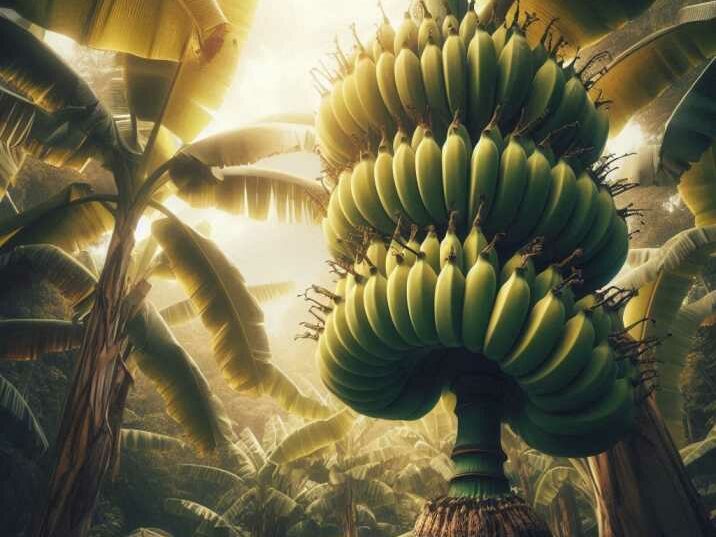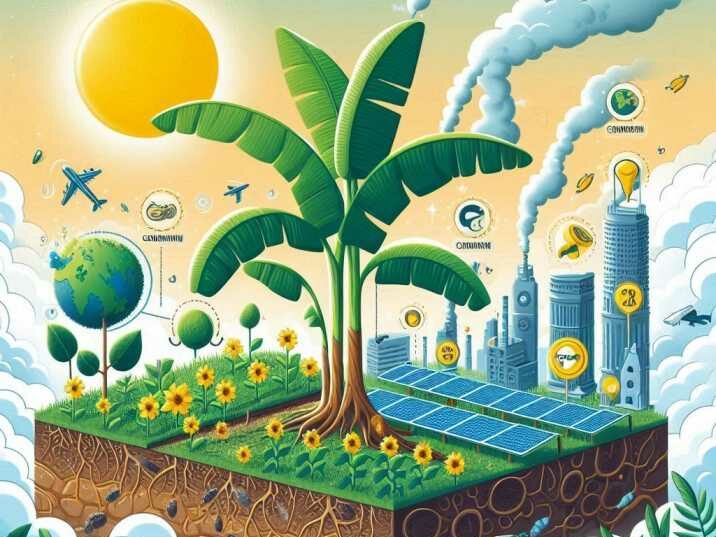Cavendish bananas are the most popular type of bananas worldwide, loved for their sweet taste and convenient size. However, the vast plantations where these bananas are grown have significant effects on the environment. One of the most important environmental aspects is carbon sequestration, which is how plants and trees help remove carbon dioxide (CO2) from the atmosphere, storing it in the ground and their tissues. In this article, we will explore how Cavendish banana plantations impact carbon sequestration and what this means for our planet.
Introduction to Carbon Sequestration
Table of Contents
What Is Carbon Sequestration?
Carbon sequestration is the process by which plants, soils, and oceans absorb and store carbon dioxide from the atmosphere. This is crucial in reducing the greenhouse effect and combating climate change. Forests and large areas of vegetation play a significant role in this process by storing carbon in trees and soil.
Reduces Greenhouse Gases
What Are Greenhouse Gases?
- Greenhouse gases (GHGs) include carbon dioxide (CO2), methane (CH4), nitrous oxide (N2O), and water vapor. These gases trap heat in the atmosphere, which leads to the warming of the Earth’s surface.
How Carbon Sequestration Helps
- Absorption of CO2: Plants absorb CO2 during photosynthesis, converting it into oxygen and glucose. This process helps lower the amount of CO2, a major greenhouse gas, in the atmosphere.
- Climate Change Mitigation: By reducing CO2 levels, carbon sequestration helps slow down the rate of global warming and climate change, which are driven by the accumulation of greenhouse gases.
Promotes Biodiversity
What Is Biodiversity?
- Biodiversity refers to the variety of life on Earth, including different plants, animals, and microorganisms, and the ecosystems they form. High biodiversity is crucial for a healthy and resilient ecosystem.
How Carbon Sequestration Helps
- Healthy Ecosystems: Ecosystems with high levels of carbon sequestration, such as forests and wetlands, are often rich in biodiversity. These ecosystems provide habitats for numerous species, supporting diverse plant and animal life.
- Resilience to Changes: Biodiverse ecosystems are more resilient to changes and disturbances, such as disease outbreaks and extreme weather events. By maintaining these ecosystems, carbon sequestration supports a stable and balanced environment.
Improves Air Quality
What Is Air Quality?
- Air quality refers to the cleanliness of the air we breathe. Poor air quality, often caused by pollution, can lead to health problems for humans and animals.
How Carbon Sequestration Helps
- Oxygen Production: Through photosynthesis, plants convert CO2 into oxygen, improving the quality of air and making it healthier for humans and animals to breathe.
- Pollution Reduction: Trees and plants help filter pollutants from the air, such as dust, smoke, and other harmful particles, contributing to cleaner and fresher air.
Cavendish Banana Plantations and the Environment
What Are Cavendish Bananas?
Cavendish bananas are the most widely grown and consumed type of banana worldwide. They are named after William Cavendish, the Duke of Devonshire, who was one of the first to cultivate them in the 19th century.
Where Are Cavendish Bananas Grown?
Cavendish bananas are primarily grown in tropical regions, such as:
- Central and South America
- Southeast Asia
- Africa
These areas provide the warm and humid conditions necessary for banana cultivation.
Environmental Impact of Banana Plantations
- Land Use: Large areas of land are cleared to make room for banana plantations, leading to deforestation.
- Water Usage: Bananas require a lot of water, which can deplete local water sources.
- Chemical Use: Fertilizers and pesticides are commonly used to protect the crops, which can harm the environment.

How Cavendish Banana Plantations Affect Carbon Sequestration
Positive Impacts
While banana plantations have some negative environmental impacts, they also have positive effects on carbon sequestration:
- Photosynthesis: Like all plants, banana trees perform photosynthesis, absorbing CO2 and releasing oxygen.
- Carbon Storage: The banana plants themselves store carbon in their trunks and leaves.
Negative Impacts
However, there are also challenges associated with banana plantations and carbon sequestration:
- Deforestation: Clearing forests to plant bananas reduces the overall capacity of the land to sequester carbon.
- Soil Degradation: Intensive farming can lead to soil degradation, reducing the soil’s ability to store carbon.
- Monoculture Practices: Planting only one type of crop, like Cavendish bananas, can harm soil health and reduce biodiversity, affecting carbon sequestration negatively.
Enhancing Carbon Sequestration in Banana Plantations
Sustainable Practices
There are ways to make banana plantations more sustainable and increase their ability to sequester carbon:
- Agroforestry: Integrating trees into banana plantations can increase carbon storage and support biodiversity.
- Cover Crops: Planting cover crops between banana plants can improve soil health and carbon sequestration.
- Organic Farming: Reducing chemical use can help maintain healthy soil and promote better carbon storage.
Technological Innovations
- Remote Sensing: Using satellite technology to monitor carbon levels and health in plantations.
- Soil Management Techniques: Employing advanced methods to improve soil carbon storage, such as no-till farming.

Table of Information: Cavendish Banana Plantations and Carbon Sequestration
| Aspect | Details |
|---|---|
| Carbon Sequestration | Process of capturing and storing atmospheric CO2 |
| Main Regions | Central and South America, Southeast Asia, Africa |
| Environmental Challenges | Deforestation, water usage, chemical use |
| Positive Contributions | Photosynthesis, carbon storage in plants |
| Sustainable Practices | Agroforestry, cover crops, organic farming |
| Technological Innovations | Remote sensing, advanced soil management techniques |
Conclusion
Cavendish banana plantations have both positive and negative impacts on carbon sequestration. While they do capture and store carbon, the environmental challenges associated with large-scale banana farming can reduce these benefits. By adopting sustainable practices and technological innovations, we can enhance the carbon sequestration potential of banana plantations, contributing to a healthier planet.
FAQs
1. What is carbon sequestration?
Carbon sequestration is the process of capturing and storing carbon dioxide from the atmosphere in plants, soil, and oceans.
2. How do banana plantations affect carbon sequestration?
Banana plantations can both absorb CO2 through photosynthesis and reduce carbon storage capacity if they lead to deforestation and soil degradation.
3. Why are Cavendish bananas so popular?
Cavendish bananas are popular due to their sweet taste, convenient size, and wide availability.
4. What are some sustainable practices for banana farming?
Sustainable practices include agroforestry, planting cover crops, and using organic farming methods.
5. How can technology help improve carbon sequestration in plantations?
Technology can help by monitoring carbon levels and improving soil management through advanced techniques.
